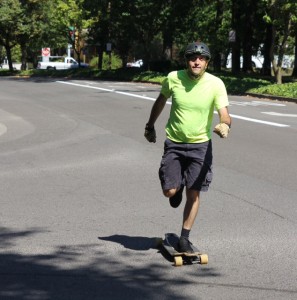We’re kicking off a regular series called My View. It’s an opportunity for people to share their view on aspects of transportation. Today, we take a look at skateboards.
By Cory Poole
The first step to thinking about skateboards as active transportation is forgetting everything you know about skateboarding. Once you have removed the flip tricks, grinds and big airs from your mind, you can start to see skateboarding as a really practical way to get around.
The last ten years has seen explosive growth of the longboarding industry fueled largely by better, more affordable equipment, and teen riders. Many former college students have continued longboarding into their adult life. Increasing numbers of adult riders have also picked up longboarding as a less injury prone alternative to traditional skateboarding.
A modern longboard (or a skateboard with a long wheelbase) can easily cruise around 10 MPH, with a small amount of training they can steer and stop as well as many bicycles. Skateboarding is a healthy physical activity. Skateboards are inexpensive to purchase and maintenance is minimal. Transition on and off of public transportation is a breeze and skateboards can easily stored at home, work or school. Skateboards are an ideal form of transportation for those trips that are to far to walk but to close to justify getting on the bike or in the car.
So what’s holding skateboard transportation back? Probably the largest single contributor to skateboarding’s image problem is the social stigma around riding. Continue reading

